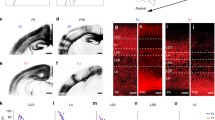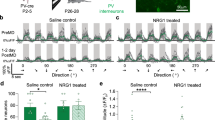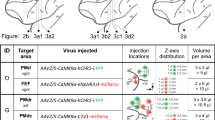Abstract
In adult rats, cortical neurones that send axons through the pyramidal tract are confined to layer V, over the rostral two-thirds of the cerebral hemisphere1–3. However, during the first postnatal week, many neurones in layer V in the occipital cortex (including the visual cortex) also extend axon collaterals through the pyramidal tract and into the spinal cord2,4–6. These occipital corticospinal collaterals are completely eliminated over the subsequent 2 weeks6, although their cells of origin do not die2. We now report that when portions of the occipital cortex from fetal rats are transplanted to more rostral cortical regions of newborn rats, some of the transplanted neurones not only extend axons through the pyramidal tract, but also maintain these axons beyond the stage at which they are normally eliminated. These results suggest that normally-eliminated cortical axons can be ‘rescued’ and, in the case of pyramidal tract neurones, the position of the neurones within the tangential plane of the cortex is a critical factor in determining which neurones retain and which lose their pyramidal tract collaterals.
This is a preview of subscription content, access via your institution
Access options
Subscribe to this journal
Receive 51 print issues and online access
$199.00 per year
only $3.90 per issue
Buy this article
- Purchase on Springer Link
- Instant access to full article PDF
Prices may be subject to local taxes which are calculated during checkout
Similar content being viewed by others
References
Wise, S. P., Murray, E. A. & Coulter, J. D. Neuroscience 4, 65–78 (1979).
Stanfield, B. B., O'Leary, D. D. M. & Fricks, C. Nature 298, 371–373 (1982).
Bates, C. A. & Killackey, H. P. Devl Brain Res. 13, 265–273 (1984).
Stanfield, B. B. & O'Leary, D. D. M. Soc. Neurosci. Abstr. 8, 438 (1982).
Stanfield, B. B. & O'Leary, D. D. M. Soc. Neurosci. Abstr. 9, 375 (1983).
Stanfield, B. B. & O'Leary, D. D. M. J. comp. Neurol. (submitted).
Floeter, M. K. & Jones, E. G. J. Neurosci 4, 141–150 (1984).
Rogers, A. W. Techniques of Autoradiography (Elsevier, Amsterdam, 1973).
Schreyer, D. J. & Jones, E. G. Neuroscience 7, 1837–1853 (1982).
Bruckner, G., Mares, V. & Biesold, D. J. comp. Neurol. 166, 245–256 (1976).
Lund, R. D., Mitchell, D. E. & Henry, G. H. Brain Res. 144, 169–172 (1978).
Innocenti, G. M. & Frost, D. O. Nature 280, 231–234 (1979); Expl Brain Res. 39, 365–375 (1980).
Rhoades, R. W. & Dellacroce, D. D. Brain Res. 246, 146–149 (1982).
Cusick, C. G. & Lund, R. D. J. comp. Neurol. 212, 385–398 (1982).
Rothblat, L. A. & Hayes, L. L. Brain Res. 246, 146–149 (1982).
Berman, N. E. & Payne, B. R. Brain Res. 274, 201–212 (1983).
Lund, R. D., Chang, F.-L. F. & Land, P. W. Devl Brain Res. 14, 139–142 (1984).
Caviness, V. S. Jr & Yorke, C. H. J. comp. Neurol. 170, 449–460 (1976).
Caviness, V. S. Jr & Rakic, P. A. Rev. Neurosci. 1, 279–326 (1978).
Lemmon, V. & Pearlman, A. L. J. Neurosci. 1, 83–93 (1981).
Simmons, P. A., Lemmon, V. & Pearlman, A. L. J. comp. Neurol. 211, 295–308 (1982).
Terashima, T., Inoue, K., Inoue, Y., Mikoshiba, K. & Tsukada, Y. J. comp. Neurol. 218, 314–326 (1983).
Jensen, K. F. & Killackey, H. P. Proc. natn. Acad. Sci. U.S.A. 81, 964–968 (1984).
Cowan, W. M., Gottlieb, D. I., Hendrickson, A. E., Price, J. L. & Woolsey, T. A. Brain Res. 37, 21–51 (1972).
Author information
Authors and Affiliations
Rights and permissions
About this article
Cite this article
Stanfield, B., O'Leary, D. Fetal occipital cortical neurons transplanted to the rostral cortex can extend and maintain a pyramidal tract axon. Nature 313, 135–137 (1985). https://doi.org/10.1038/313135a0
Received:
Accepted:
Issue Date:
DOI: https://doi.org/10.1038/313135a0
This article is cited by
-
Developmentally primed cortical neurons maintain fidelity of differentiation and establish appropriate functional connectivity after transplantation
Nature Neuroscience (2018)
-
Long distance axonal growth in the adult central nervous system
Journal of Neurology (1994)
Comments
By submitting a comment you agree to abide by our Terms and Community Guidelines. If you find something abusive or that does not comply with our terms or guidelines please flag it as inappropriate.



